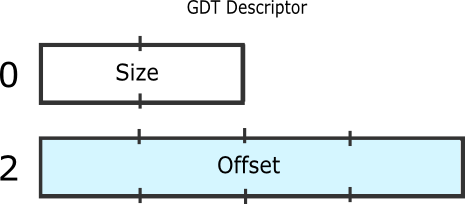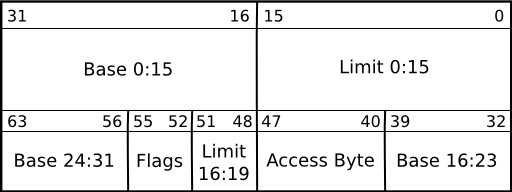[翻译]Global Descriptor Table-GDT
全局描述符表(GDT)是 Intel x86 系列处理器(从 80286 开始)所使用的一种数据结构,目的是为了在程序运行期间划分具有不同属性的内存区域,比如:可以运行、可写入等区域的起始地址与访问权限。这些区域被称作段。
全局描述符表除了可以保存段信息外还可以保存其它信息。全局描述符表中的每个表项(描述子)长度为 8-byte,全局描述符表的选择子可以为:任务状态描述子(TSS)、本地描述符表描述子或者调用门描述子。调用门在 x86 不同特权级中转移控制权非常重要,但是现在的操作系统很少使用这种机制。
同时存在的还有局部描述符表(LDT)。局部描述符表用来存储程序内部的段信息,而全局描述符表用来描述全局的段信息。x86 系列的处理器具有一种机制,可以在发生某些事件时自动切换局部描述符表,但是针对全局描述符表却没有这样的机制。
程序可以访问的内存通常被限制在一个段内。在 386 及以后的处理器中,由于 32 位的段内偏移与段大小的原因,有可能使段覆盖全部可寻址的空间,并且相关的段对用户来说也使透明的。
程序如果想使用某个段,需要在全局描述符表或者局部描述符表中找到该段对应的索引。这个索引被称为段选择子。为了使用相应的段,段选择子必须被首先加载到段寄存器。除了可以通过机器指令读取或者设置全局描述符表(还有中断描述符表)的内存地址外,指令所引用的内存地址存在于一个隐式的段,有时有两个。大部分情况下,默认的段寄存器可以通过在地址前面加一个段地址来替换。加载段选择子到段寄存器的过程中,程序会自动读取全局描述符表或者局部描述符表,并将相关信息保存到处理器中。在全局描述符表或者局部描述符表被加载后,对二者的修改并不会起作用,除非重新将相应的表加载到寄存器。
64 位下全局描述符表
全局描述符表在 64 位下仍然是合法可用的。相应的寄存器位数从 48 位扩展到了 80 位,64 位的段选择子是平坦的、无限制的(从 0x0000000000000000 到 0xFFFFFFFFFFFFFFFF)。64 位版本的 Windows 仍然禁止对全局表述附表的 hook 操作,如果进行这种操作会引发一个系统错误。
=========================================================================
386 处理器保护机制的重要方面就是全局描述符表。全局描述符表定义了一些内存区域的基本访问权限。可以使用全局描述符表中一个表项来描述一个段非法访问异常,这样,在进程进行了非法操作时,内核可以有机会终止进程。现代的大部分操作系统使用分页来实现这个机制:这种机制更加通用,给了上层更加大的灵活性。全局描述符表同样可以定义一块内存区域是可执行的,还是普通数据。全局描述符表有能力定义任务状态段(TSS)。TSS 用来实现基于硬件的多任务,这里不讨论。但是需要说明的是 TSS 并不是实现多任务的唯一方法。
GRUB 已经为我们加载了一个全局描述符表,如果我们重写了 GRUB 已经加载了的内存(全局描述符表所占空间),我们会破坏全局描述符表,并会引发一个 “triple fault” 错误。后果是引起机器重启。我们应该在有权限访问的内存中定义自己的全局描述符表,从而避免这个问题。这就需要我们重建全局描述符表,告诉处理器全局描述符表的位置,最后需要重新设置CS, DS, ES, FS, and GS,将其对应到我们自己的全局描述符表。CS 通常被称为代码段寄存器。代码段寄存器可以向处理器提供代码段在全局描述符表中偏移量,同时还提供了当前可执行代码的访问权限。同样,DS 向处理器提供了当前数据的访问权限。ES, FS, GS 只是改变 DS,对我们来说不重要。
全局描述符表是一个每个表项 64 位的表。每个表项定义了可以使用的内存区域的:起始,长度,访问权限。通用规则是:全局描述符表的第一个表项是 0,是一个空的描述符。段寄存器不应该被设置为 0,否则引发一个保护错,保护错是处理器的一种保护机制。保护错与处理器的其它保护机制在 http://www.osdever.net/bkerndev/Docs/isrs.htm 有详细介绍。
每个表项还定义了处理器当前正在运行的代码是在系统层(Ring0)还是在应用程序层(Ring3)。还有其它的 Ring,但是不重要。现在主要的操作系统都只使用 Ring0 与 Ring3。作为一个基本规则:如果应用程序访问 Ring0 ,会引发一个异常。这是为了让应用程序不会使系统崩溃。在全局描述符表部分所涉及的 Ring,主要是定了处理器是否可以执行某些特权指令。某些指令是特权级的,意味着只能在高特权的 Ring 中执行。例如:cli,sti 会禁用或者启用中断。如果允许应用程序使用 cli 与 sti,那它就可以终止内核的运行。
全局描述服表项
|
|
|
在作为练习的系统内核中,我们会定义一个具有 3 个表项的全局描述符表。为什么 3 个?我们需要一个 'dummy' descriptor,来演示处理的保护特性。我们还需要一个代码段,一个数据段。我们使用 lgdt 指令来让处理器重新加载全局描述符表。使用 lgdt 指令需要一个指针,该指针指向一个 48 位的结构。48 位结构的前 16 位定义了全局描述符表的大小,剩下的 32 位是全局描述符表在内存中的起始地址。
我们可以简单的使用具有 3 个元素的数组来定义全局描述符表。
全局描述符表的一个实现:
#include < system.h >/* Defines a GDT entry. We say packed, because it prevents the
* compiler from doing things that it thinks is best: Prevent
* compiler "optimization" by packing */
struct gdt_entry
{unsigned short limit_low;unsigned short base_low;unsigned char base_middle;unsigned char access;unsigned char granularity;unsigned char base_high;
} __attribute__((packed));/* Special pointer which includes the limit: The max bytes
* taken up by the GDT, minus 1. Again, this NEEDS to be packed */
struct gdt_ptr
{unsigned short limit;unsigned int base;
} __attribute__((packed));/* Our GDT, with 3 entries, and finally our special GDT pointer */
struct gdt_entry gdt[3];
struct gdt_ptr gp;/* This will be a function in start.asm. We use this to properly
* reload the new segment registers */
extern void gdt_flush();
; This will set up our new segment registers. We need to do ; something special in order to set CS. We do what is called a ; far jump. A jump that includes a segment as well as an offset. ; This is declared in C as 'extern void gdt_flush();' global _gdt_flush ; Allows the C code to link to this extern _gp ; Says that '_gp' is in another file _gdt_flush:lgdt [_gp] ; Load the GDT with our '_gp' which is a special pointermov ax, 0x10 ; 0x10 is the offset in the GDT to our data segmentmov ds, axmov es, axmov fs, axmov gs, axmov ss, axjmp 0x08:flush2 ; 0x08 is the offset to our code segment: Far jump! flush2:ret ; Returns back to the C code!
/* Setup a descriptor in the Global Descriptor Table */
void gdt_set_gate(int num, unsigned long base, unsigned long limit, unsigned char access, unsigned char gran)
{/* Setup the descriptor base address */gdt[num].base_low = (base & 0xFFFF);gdt[num].base_middle = (base >> 16) & 0xFF;gdt[num].base_high = (base >> 24) & 0xFF;/* Setup the descriptor limits */gdt[num].limit_low = (limit & 0xFFFF);gdt[num].granularity = ((limit >> 16) & 0x0F);/* Finally, set up the granularity and access flags */gdt[num].granularity |= (gran & 0xF0);gdt[num].access = access;
}/* Should be called by main. This will setup the special GDT
* pointer, set up the first 3 entries in our GDT, and then
* finally call gdt_flush() in our assembler file in order
* to tell the processor where the new GDT is and update the
* new segment registers */
void gdt_install()
{/* Setup the GDT pointer and limit */gp.limit = (sizeof(struct gdt_entry) * 3) - 1;gp.base = &gdt;/* Our NULL descriptor */gdt_set_gate(0, 0, 0, 0, 0);/* The second entry is our Code Segment. The base address* is 0, the limit is 4GBytes, it uses 4KByte granularity,* uses 32-bit opcodes, and is a Code Segment descriptor.* Please check the table above in the tutorial in order* to see exactly what each value means */gdt_set_gate(1, 0, 0xFFFFFFFF, 0x9A, 0xCF);/* The third entry is our Data Segment. It's EXACTLY the* same as our code segment, but the descriptor type in* this entry's access byte says it's a Data Segment */gdt_set_gate(2, 0, 0xFFFFFFFF, 0x92, 0xCF);/* Flush out the old GDT and install the new changes! */gdt_flush();
}
=========================================================================
在 Intel 架构的处理器中,更确切的说是在保护模式下,内存管理与中断服务程序的控制是通过描述符表(tables of descriptors)来实现的。每个描述符的表项保存了处理器在某个时间要用的信息(例如:服务例程,任务,代码,数据等等)。如果你试着为段寄存器设置一个新值,处理器会进行关于安全与访问控制的检查。一旦通过检查,处理器会在内部寄存器中缓存这些值。
Intel 系列的处理器定义了三张表:中断描述符表,全局表述附表,局部描述符表。可以通过 LIDT,LGDT,LLDT 三个指令来加载这三张表。在大多数情况下,系统只是在启动时告诉处理器这三张表的位置,然后在以后的运行过程中通过指针来读取或者修改这三张表。
全局描述符表中应该存放什么信息?
如果完成的话,表中应该保存如下信息:
× 处理器从不引用的空指针。如果不设置,某些模拟器会抱怨缺少 limit exception。某些情况下,只是在这个位置保存指向全局描述符表自身的指针。
× 代码段描述子。对于内核来说,这个表项的类型为 0x9A。
× 数据段描述子。因为无法向代码段中写数据,因此需要添加数据段,类型为 0x92。
× 任务状态描述子。最好为这个段保留一定空间。
× 其它描述子空间。例如:用户界别(user-level),局部描述符表,更多的任务状态描述子。
Sysenter/Sysexit
如果你想使用 Intel 的 Sysenter/Sysexit 例程,那么全局描述符表必须这样组织:
× 前面提到的一些段(NULL 描述子,kernel stuff,等等)
× DPL0 代码段描述子。Sysenter 使用。
× DPL0 数据段描述子。Sysenter 栈使用。
× DPL3 代码段描述子。Sysexit 后需要执行的代码。
× DPL3 数据段描述子。在 Sysexit 后,用户态的栈。
× 其它描述子。
DPL0 代码段的内容被加载到 MSR。其它值通过这个值来计算。具体参考 Intel 的手册。
平坦模式初始化(
Flat Setup)
如果想使用不需要翻译(查表,转换)的 4 G 空间:
GDT[0] = {.base=0, .limit=0, .type=0}; // Selector 0x00 cannot be used
GDT[1] = {.base=0, .limit=0xffffffff, .type=0x9A}; // Selector 0x08 will be our code
GDT[2] = {.base=0, .limit=0xffffffff, .type=0x92}; // Selector 0x10 will be our data
GDT[3] = {.base=&myTss, .limit=sizeof(myTss), .type=0x89}; // You can use LTR(0x18)在这种模式下,没有办法保护代码段不可写,因为代码段与数据段是重叠的。
微内核模式初始化(Small Kernel Setup)
如果基于某种原因需要将代码段与数据段分开,并且假设每个有 4M 空间,起始与 4M。
GDT[0] = {.base=0, .limit=0, .type=0}; // Selector 0x00 cannot be used
GDT[1] = {.base=0x04000000, .limit=0x03ffffff, .type=0x9A}; // Selector 0x08 will be our code
GDT[2] = {.base=0x08000000, .limit=0x03ffffff, .type=0x92}; // Selector 0x10 will be our data
GDT[3] = {.base=&myTss, .limit=sizeof(myTss), .type=0x89}; // You can use LTR(0x18)这意味着在物理内存 4M 空间内的信息可以从 CS:0 开始访问。物理内存 8M 空间内的信息可以从 DS:0 开始访问。这不是一个好的设计。
具体应该怎么操作呢?
禁用中断
如果中断处于开启状态,就禁用中断,否则是自找麻烦。
向表格中填充数据
我们现在还没有给出 GDT[] 的具体结构。这是有目的的。描述子的实际结构因为某种原因有点混乱。地址被分成三个部分,无法进行编码限制,同时还要正确设置很多标志位。
/*** /param target A pointer to the 8-byte GDT entry* /param source An arbitrary structure describing the GDT entry*/
void encodeGdtEntry(uint8_t *target, struct GDT source)
{// Check the limit to make sure that it can be encodedif ((source.limit > 65536) && (source.limit & 0xFFF) != 0xFFF)) {kerror("You can't do that!");}if (source.limit > 65536) {// Adjust granularity if requiredsource.limit = source.limit >> 12;target[6] = 0xC0;} else {target[6] = 0x40;} // Encode the limittarget[0] = source.limit & 0xFF;target[1] = (source.limit >> 8) & 0xFF;target[6] |= (source.limit >> 16) & 0xF; // Encode the base target[2] = source.base & 0xFF;target[3] = (source.base >> 8) & 0xFF;target[4] = (source.base >> 16) & 0xFF;target[7] = (source.base >> 24) & 0xFF; // And... Typetarget[5] = source.type;
}告诉处理器去哪里寻找全局表述附表
使用 LGDT 指令设置。
对于实模式
线性地址是通过段基址右移 4 位,然后加上段内偏移获得的。假设 GDT 和 GDT_end 两个符号在当前的数据段:
gdtr DW 0 ; For limit storageDD 0 ; For base storage setGdt:XOR EAX, EAXMOV AX, DSSHL EAX, 4ADD EAX, ''GDT''MOV [gdtr + 2], eaxMOV EAX, ''GDT_end''SUB EAX, ''GDT''MOV [gdtr], AXLGDT [gdtr]RET
平坦的保护模式下
平坦意味着数据段的地址从 0 开始。如果通过 GRUB 进行引导就是这种情况。假设你调用 setGdt(GDT, sizeof(GDT)):
gdtr DW 0 ; For limit storageDD 0 ; For base storage setGdt:MOV EAX, [esp + 4]MOV [gdtr + 2], EAXMOV AX, [ESP + 8]MOV [gdtr], AXLGDT [gdtr]RET
非平坦的保护模式
如果数据段的起始地址不是 0,就属于这种模式。
需要:
"MOV EAX, ..."
"ADD EAX, base_of_your_data_segment_which_you_should_know"
"MOV ..., EAX"
重新设置各个段寄存器
无论怎么修改全局描述符表,如果没有设置各个段寄存器,修改不会起作用。
reloadSegments:; Reload CS register containing code selector:JMP 0x08:reload_CS ; 0x08 points at the new code selector .reload_CS:; Reload data segment registers:MOV AX, 0x10 ; 0x10 points at the new data selectorMOV DS, AXMOV ES, AXMOV FS, AXMOV GS, AXMOV SS, AXRET
为什么局部描述符表很特别?
像全局描述符表一样,局部描述符表也包含关于内存区域的描述子,但是这些描述子被称作门。每个任务都可以有自己的局部描述符表,当使用硬件任务切换时,处理器会自动切换到正确的局部描述符表。
因为对于每个任务来说,局部描述符表可能不同,局部描述符表不是一个保存系统相关信息的地方,例如:任务状态描述子,或者其它局部描述符表,而这些是全局描述符表的责任。因为全局表述附表经常改变,因此他的设置与全局描述符表还有中断描述符表有些不同。局部描述符表不是通过直接设置其地址与大小完成的,那些信息被保存在了全局描述符表(选择子的类型是 LDT), 对应选择子的信息如下:
GDTR (base + limit)+-- GDT ------------+| | SELECTOR ---> [LDT descriptor ]----> LDTR (base + limit)| | +-- LDT ------------+| | | |... ... ... ...+-------------------+ +-------------------+
在 386+处理器的分页机制下,局部描述符表已经没用了。已经没有必要设置多个局部描述符选择子,因此对于系统开发来说可以忽略处理器的这个特性了。
什么是中断描述符表?是否需要中断描述符表?
参考:http://wiki.osdev.org/index.php?title=Interrupts_for_dummies&action=edit
=========================================================================
GDT 的加载使用 LDGT 指令。GDT 的结构如下:

offset 是表格自身的虚拟地址。size 为表格的大小减一。原因是:size 的最大值是 65535,而全局描述符表对打可以还有 65536 byte(8192 个表项)。每个表项 8byte,其复杂的结构如下:

What "Limit 0:15" means is that the field contains bits 0-15 of the limit value. The base is a 32 bit value containing the linear address where the segment begins. The limit, a 20 bit value, tells the maximum addressable unit (either in 1 byte units, or in pages). Hence, if you choose page granularity (4 KiB) and set the limit value to 0xFFFFF the segment will span the full 4 GiB address space. Here is the structure of the access byte and flags:

The bit fields are:
- Pr: Present bit. This must be 1 for all valid selectors.
- Privl: Privilege, 2 bits. Contains the ring level, 0 = highest (kernel), 3 = lowest (user applications).
- Ex: Executable bit. If 1 code in this segment can be executed, ie. a code selector. If 0 it is a data selector.
- DC: Direction bit/Conforming bit.
- Direction bit for data selectors: Tells the direction. 0 the segment grows up. 1 the segment grows down, ie. the offset has to be greater than the base.
- Conforming bit for code selectors:
- If 1 code in this segment can be executed from an equal or lower privilege level. For example, code in ring 3 can far-jump to conforming code in a ring 2 segment. The privl-bits represent the highest privilege level that is allowed to execute the segment. For example, code in ring 0 cannot far-jump to a conforming code segment with privl==0x2, while code in ring 2 and 3 can. Note that the privilege level remains the same, ie. a far-jump form ring 3 to a privl==2-segment remains in ring 3 after the jump.
- If 0 code in this segment can only be executed from the ring set in privl.
- RW: Readable bit/Writable bit.
- Readable bit for code selectors: Whether read access for this segment is allowed. Write access is never allowed for code segments.
- Writable bit for data selectors: Whether write access for this segment is allowed. Read access is always allowed for data segments.
- Ac: Accessed bit. Just set to 0. The CPU sets this to 1 when the segment is accessed.
- Gr: Granularity bit. If 0 the limit is in 1 B blocks (byte granularity), if 1 the limit is in 4 KiB blocks (page granularity).
- Sz: Size bit. If 0 the selector defines 16 bit protected mode. If 1 it defines 32 bit protected mode. You can have both 16 bit and 32 bit selectors at once.
转载于:https://www.cnblogs.com/Proteas/archive/2010/11/28/2335682.html
[翻译]Global Descriptor Table-GDT相关推荐
- gdt描述_GDT(Global Descriptor Table)全局描述符表
在IA32下,CPU有两种工作方式:实模式和保护模式.当我们按下开机按钮以后,CPU是工作在实模式下的,经过某种机制以后才进入保护模式. Intel 8086是16为的CPU,有16为的寄存器.16位 ...
- GLOBAL TEMPORARY TABLE
转自:http://tolywang.itpub.net/index.php CREATE GLOBAL TEMPORARY TABLE TABLENAME ( COL1 VARCHAR2(10), ...
- IDT系列:(一)初探IDT,Interrupt Descriptor Table,中断描述符表
IDT,Interrupt Descriptor Table,中断描述符表是CPU用来处理中断和程序异常的. 一.有关IDT的基本知识 1.中断时一种机制,用来处理硬件需要向CPU输入信息的情况. 比 ...
- Oracle - 临时表(GLOBAL TEMPORARY TABLE)
http://aofengblog.blog.163.com/blog/static/6317021200951664351836/ Oracle - 临时表(GLOBAL TEMPORARY TAB ...
- vlad用python实现_HF-Net(一)基于NetVLAD的global descriptor的特征提取
0.数据准备及预训练权重 以Aachen Day-Night dataset为例,该数据集目录结构如下:aachen存放在编译HF-Net时设置的DATA_PATH下 基于NetVLAD的global ...
- 【泄漏类】android7.0 system_server发生global reference table overflow问题分析
1.问题描述 旋转屏测试5-6小时system_server发生abort,手机重启导致测试停止,android7.0平台多个项目都有此问题爆出. 和测试同事了解旋转屏幕在settings界面进行操作 ...
- HF-Net(一)基于NetVLAD的global descriptor的特征提取
参考:HF-Net git地址 0.数据准备及预训练权重 以Aachen Day-Night dataset为例,该数据集目录结构如下:aachen存放在编译HF-Net时设置的DATA_PATH下 ...
- Linux Kernel TCP/IP Stack — L1 Layer — NIC Controller — Buffer descriptor table
目录 文章目录 目录 DMA 与 Buffer descriptor DMA 与 Buffer descriptor NIC Controller 会在 RAM 中建立并为例两个环形队列,称为 BD ...
- 《Orange’s 一个操作系统的实现》3.保护模式4----LDT(Local Descriptor Table)
还是在原有代码基础上进行修改,加入LDT的使用,代码分析如下(红色部分为新增代码): 本程序是在原有完成大内存读写测试完成后,调用局部任务显示字符L ; ======================= ...
最新文章
- Rust和C / C ++的跨语言链接时间优化LTO
- Pthon JSON
- 一对一关联(one-to-one)
- oracle job 与存储过程,应用oracle job和存储过程
- Linux文件导出到Windows乱码的问题
- asp.net怎么实现按条件查询_用这个提取函数王中王,制作数据查询表
- MSRA被曝停招国防七子及北邮学生
- 每天一道剑指offer-合并两个排序的链表
- 前端直接读取文本文件内容
- iOS开发系列--Objective-C之协议、代码块、分类
- 地壳中元素含量排名记忆口诀_地壳中含量最多的元素--氧元素
- mysql 优化union_mysql优化 - MySQL中使用UNION进行两表合并,去重导致效率低下,请问如何优化?...
- Log4Cpp 使用实例
- 浅谈AlphaGo背后所涉及的深度学习技术
- 问题 1125: 【C语言训练】委派任务*【最优解】
- 七日之都账号服务器,永远的7日之都服务器数据互通吗_永远的7日之都iOS和安卓能一起玩吗_玩游戏网...
- Ubuntu 14.04重装mysql
- 全面剖析可行性研究报告的内容
- diameter协议栈_Diameter协议摘要
- FTP登录不上 显示“找不到元素” windows无法访问此文件夹,请确保输入的文件名是否正确,并且您有权访问此文件
热门文章
- 一个5节点的polardb mysql_POLARDB问题
- linux运维必学python吗_linux运维一定要学python吗?
- 安装mysql为什么下载了很多_mysql下载与安装过程
- python判断字符是否是字典的键_Python3基础 dict in/not in 查询一个字符是否指定字典的键或者值...
- matlab的index函数,写论文第九天:MATLAB之rsindex函数
- JDK7 AIO介绍
- 隐藏通知内容什么意思_降额来袭!信用卡风控短信背后,的“隐藏暗语”你懂吗?...
- oracle 相同的sql执行两次 执行计划会不一样吗,一条SQL语句,两次执行计划的差距...
- 苏格拉底的oracle,苏格拉底的五个经典故事
- php 与时间有关的函数,php中与时间相关的常用函数有哪些
